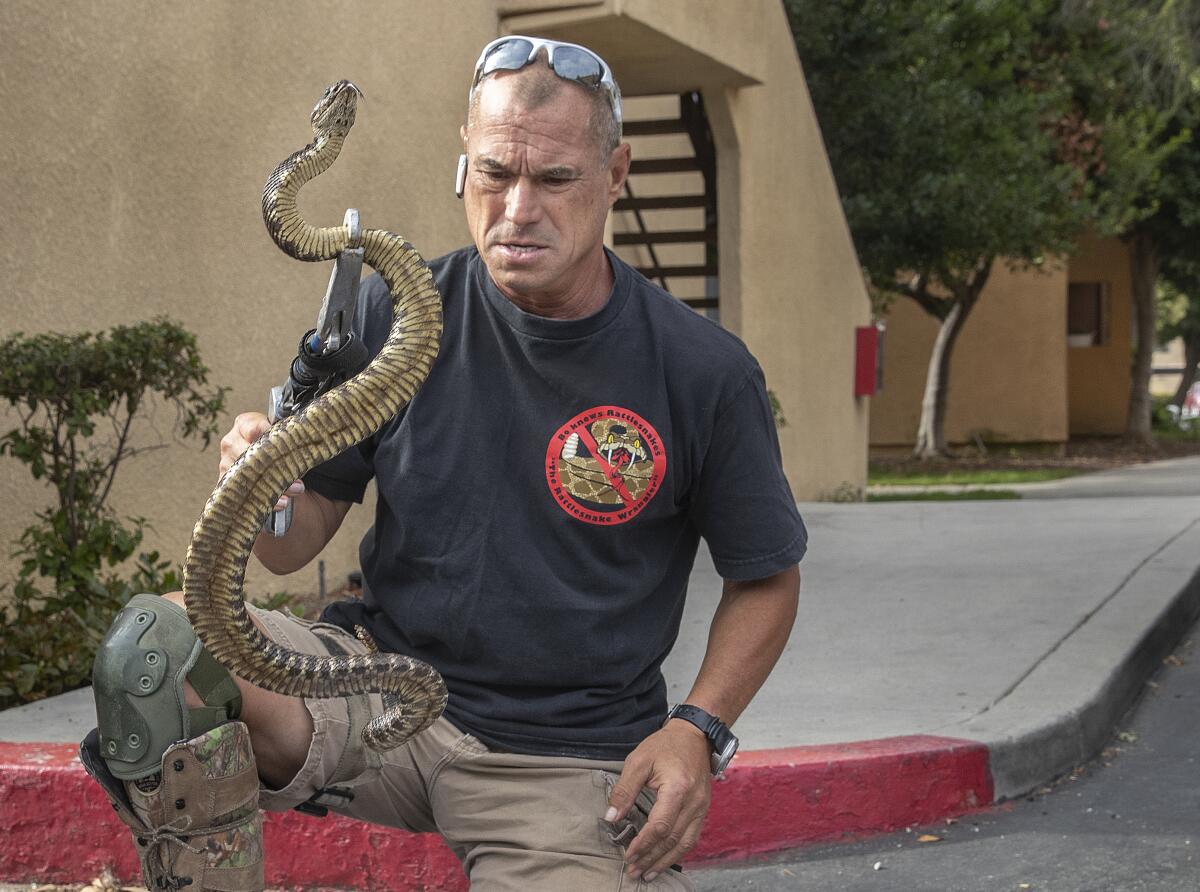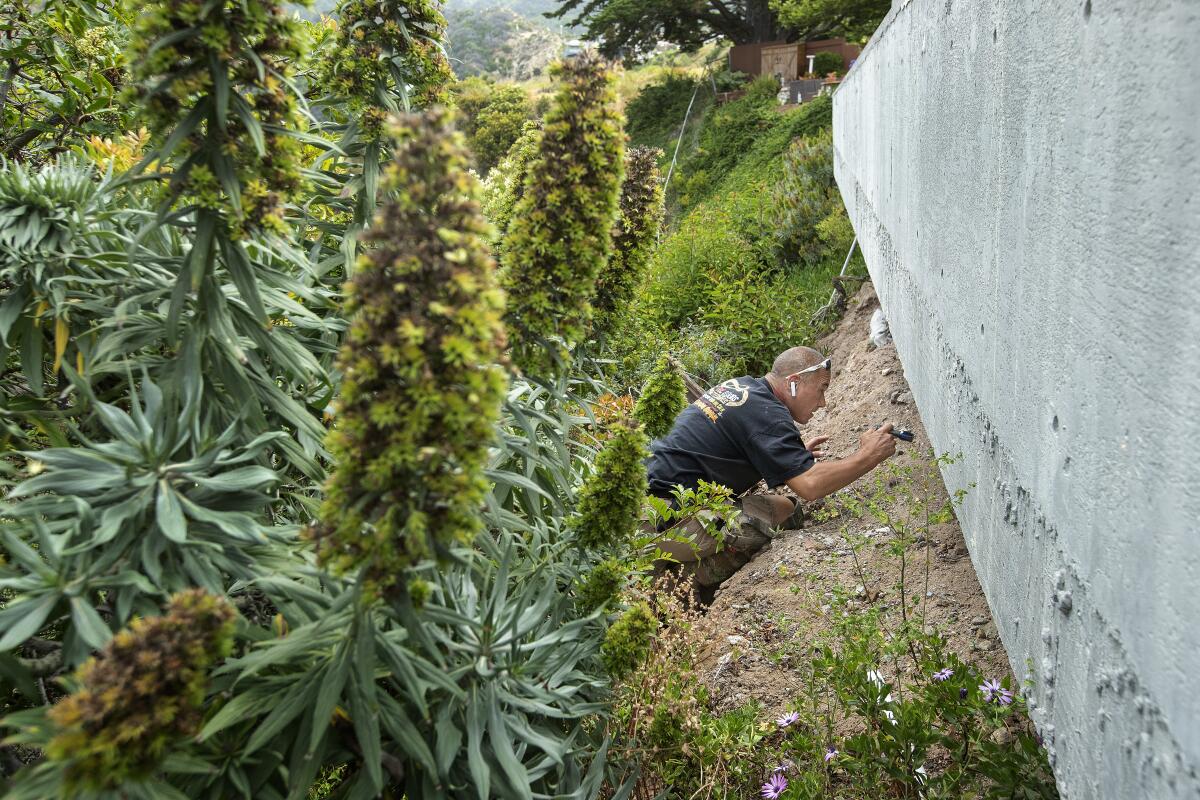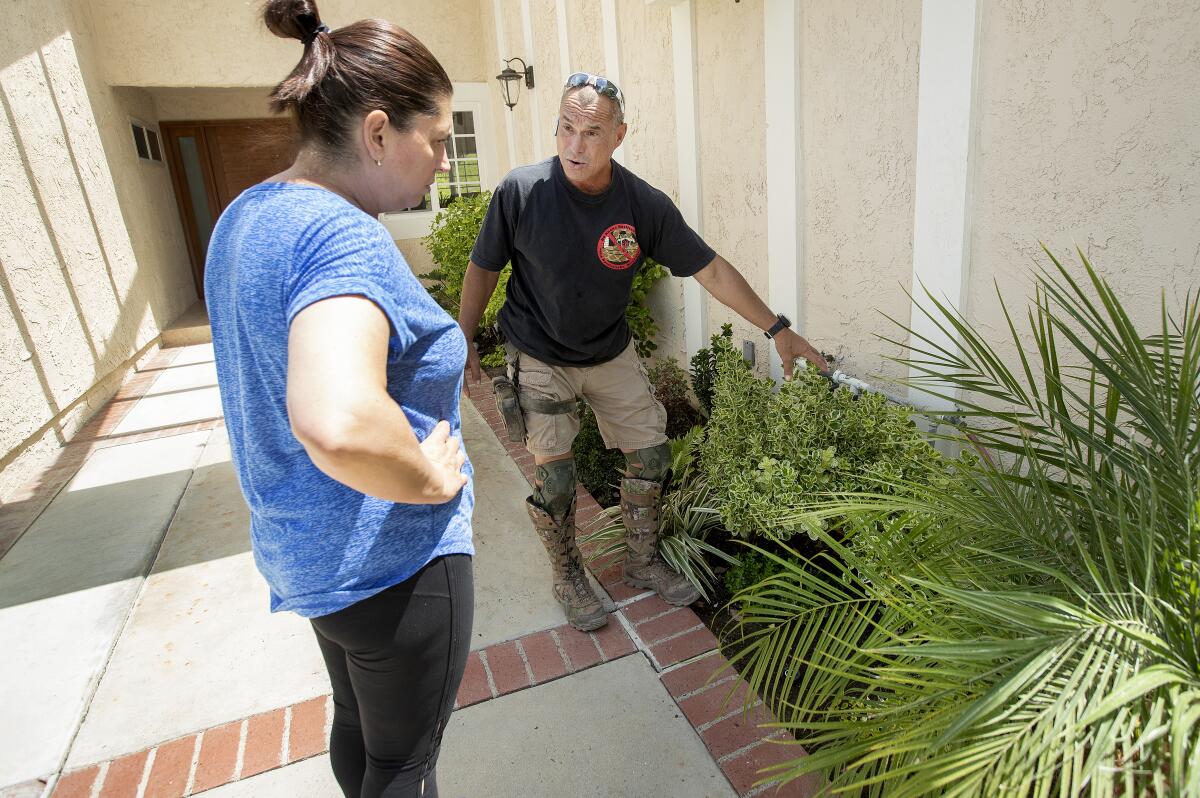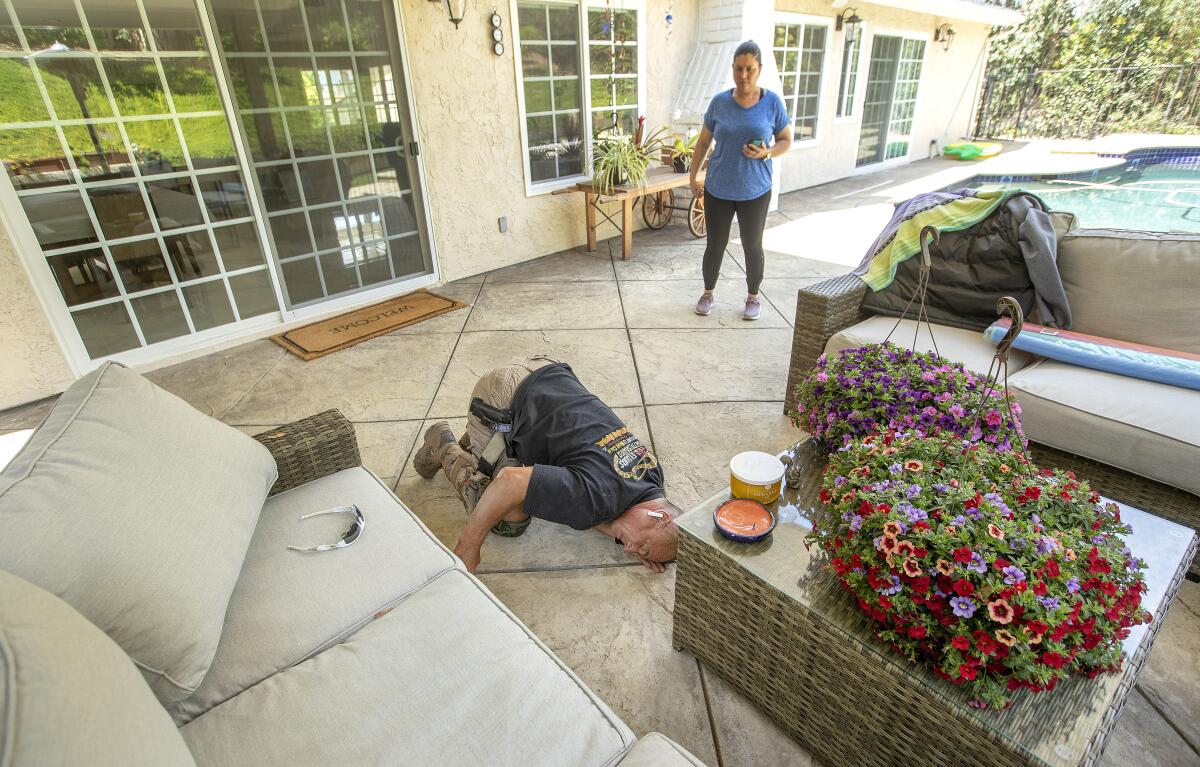Rattlesnakes have had a busy year. Same for the people who catch them for a living

- Share via
Bo Slyapich seeks what no one else wants to find.
On a recent morning, he waded into grass so high and so dense his legs disappeared from view. He crouched low and then lay on his stomach as he scoured the backyard of a house above Pacific Coast Highway.
The homeowner looked on from a safe distance. Luna, the family dog, barked as Slyapich invaded her territory, but kept back as well.
Slyapich was trying to flush out rattlesnakes from under a rock, inside a dirt hole or behind a leafy plant. For 30 minutes he hunted his prey — climbing and crawling, prodding and poking with sticks and tongs — plotting a course with the confidence and caution that come from decades of experience.
Southern California is home to at least half a dozen snake removal services that extricate the animals from their hideouts and take them away, allowing families to safely spend time in their yards. When Slyapich and other experts complete their mission, they often leave awe in their wake.
More on snake wrangling
Six myths about rattlesnakes, busted
We asked, you answered: Californians’ best snake stories
Rattlesnakes can be found up and down the state, which means, in theory, calls for assistance can come from a variety of locations. But rattlers are frequently associated with hills and mountains, and the multimillion-dollar mansions nestled among them. Slyapich’s clients have included Jamie Foxx, Dwayne Johnson, Howie Mandel, Ellen DeGeneres and Arnold Schwarzenegger.
You might think that the continuing development of what was once wilderness would reduce the rattlesnake population near homes, that our desire to tame nature will, ultimately, drive them away from where humans settle. But it often seems the opposite is true: the encroachment that upends snake habitats may make backyard encounters even more likely.

Slyapich can attest to that — he is called back to the same homes year after year. He visits some properties monthly. One client has spotted more than 100 rattlesnakes on her land.
Slyapich is well aware of the ironies of his job. As he often says to customers: “We build our homes on their homes, we just build nicer ones.”
::
On this morning, Slyapich, 61, wielded tongs to pick through brush in the backyard of the home above PCH. The home’s owner, Jonathan Markiles, explained that two days earlier his landscaper spotted a rattler in the garden — a tiny creature shaking its tail in fear.
It’s been a busy year for rattlesnakes and the people who stalk them, Slyapich said. Heavy rains allowed for more vegetation, which created more food for rodents. Fat rodents meant healthier snakes and, then, more baby rattlesnakes, sometimes as many as 20 in a single litter, he said.
“It’s just one of those bumper-crop years,” Slyapich said in a voice that is somehow both gravelly and singsong — part-surfer, part-cowboy, fitting for an explorer of the California coast.
But a drought year can mean more business for Slyapich as well. During dry years, snakes leave their homes to search for water from sprinklers and other manufactured sources. And more rattlers emerge after a fire, slithering through their charred habitats to find sustenance.
::
Stomping through grass with his knee-high camo boots, Slyapich pointed his thermal gun at the ground to take temperature readings. Because snakes cannot generate their own body heat, they gravitate toward land that is 75 to 85 degrees, he said. Locating those spots can help Slyapich locate the snakes.
In the morning chill, Slyapich didn’t find anything in Markiles’ yard. But when he walked into the neighbor’s backyard, he spotted mouse droppings, which suggested that snakes may have something to eat just a few steps away.

If the snake were to return, killing it would be considered self-defense, Slyapich said. The wrangler’s preference is to catch and release the rattlers in the wilderness, but he would rather his clients kill them than be bitten, he said.
“Shovel, shotgun and two-by-four all work.”
Climbing into his fire-engine-red pickup truck, Slyapich said to Markiles: “Hopefully I never hear from you again.” As he drove away, a bright sticker on the back warned: Beware rattlesnakes!
::
Slyapich’s family moved to Calabasas from North Hollywood in 1964 when he was 6. The boys in the neighborhood treated the nearby mountains as their playground, and the older kids taught him how to catch animals.
His mother, a science teacher, encouraged his curiosity. He handled lizards and snakes, sometimes putting them down his shirt.
“It was the Wild West, so they were basically our play toys,” he said.
A self-described adrenaline junkie, Slyapich spent a decade after college catching sharks as a commercial diver. He then worked as a movie stuntman, but eventually his snake wrangling skills became known among the crew. Production companies began hiring him to clear sets of snakes before shooting movies and TV shows.
Slyapich looks the way you might expect: biceps bulging from his tank top, skin tanned and weathered from the sun. He usually perches his sunglasses on his shaved head and wears a Bluetooth device in his ear, so he can pick up calls from his customers, no matter where he might be.
About 15 years ago, Slyapich started to offer his services to families and local businesses. For nine months of the year, he is reachable 24/7, answering calls from frightened homeowners who have spotted snakes not just in their yards, but in their car engines, pools, garages, bedroom closets, toilets, stoves, cabinets and refrigerators.
In Southern California, “fires, floods and rattlesnakes” are part of the deal, Slyapich said. “The real estate agents just don’t disclose the rattlesnake part.”
Maria Nelson, one of his longtime clients, lives on 25 acres in the hills just north of Thousand Oaks. Two rattlers have made it inside her house over the past 15 years, but she has spotted even more in the yard.
“I stopped counting at 100 last year,” said Nelson, 73.

A 911 call for a rattlesnake will summon firefighters who will most probably kill the creature on sight with a shovel. If it slithers off, the first responders leave.
A call to Slyapich, which can cost several hundred dollars, triggers a different kind of experience: If the snake has slipped away, he will hunt for it. He climbs into crawl spaces and roots around in damp corners, braving encounters with skunks, rats and spiders, which he despises. When he captures a snake, he donates it to programs for rattlesnake avoidance training for dogs, or moves it to undeveloped land (though he likes to joke that he keeps it “till the check clears”).
Driving through fog away from Markiles’ house, Slyapich nodded toward his truck’s back seat, which was lined with large crates filled with snakes, some coiled up and some trying to slither up the sides of the clear plastic. One skinny rattler wedged in a crate’s top corner threatened to make a quick escape whenever Slyapich removed the lid.
Slyapich said he doesn’t fear snakes, but respects their threat. He believes people will become less fearful if they know more about them.
In more than 50 years of handling serpents, Slyapich said he has never been bitten. Rattlers, whose bites can be fatal, don’t strike unless antagonized or taken by surprise. “People think snakes are going to come after them, follow them, chase them down,” he said. “Snakes don’t do that — especially our snakes.”
The volume of calls from people who say they have lived in a home for 35 years and had never seen a snake until now is increasing, and Slyapich believes that continued construction in once-remote areas is displacing the creatures.
“I’m going places I’ve never been before,” he said. “We’ve changed nature.”
When Slyapich arrived at his next destination, a home in Oak Park, owner Galit Naor showed him a cellphone video of her sons hacking at a rattlesnake with shovels outside the front door.
People think snakes are going to come after them, follow them, chase them down. Snakes don’t do that — especially our snakes.
— Bo Slyapich
It was one of three snakes Naor’s family had found in the frontyard in the past two weeks, she told Slyapich. When she works in her makeshift office in the garage, she props her feet up on the desk, afraid of what might slide over them down below, she said, adding:
“One more snake and I’ll sell the house.”
::
Fear of snakes is one of our most common phobias, experts say. One snake catcher said some of his customers are so scared of the reptiles they can’t look at his business card because it has a drawing of a snake.
Studies have found that babies’ eyes become unusually wide when they see snakes, suggesting people innately distrust them. Scientists say humans probably evolved to fear snakes because of the threat they posed to our ancestors, but that nervousness is reinforced by their place in the cultural imagination.
In the Harry Potter books, villain Voldemort’s trusted pet, Nagini, is a snake. Adam and Eve were famously derailed by a snake. The fearless Indiana Jones hates one thing: snakes. Calling someone “a snake” isn’t a compliment.
“It’s not really fair — snakes are given an unjust reputation,” said Rutgers University psychology professor Vanessa LoBue. “What else are 40% of adults professing to be afraid of? Other than death.”
All of which means? The wranglers are a breed apart, some of them fascinated by danger, and gratified that they can turn their fearlessness into a service for the community, similar to firefighters, experts say. And for some, there are additional perks.
“I walk up to some macho guy’s door and I’m like, ‘Hey, I’m here for your rattlesnake,’” said 31-year-old Kira Otey, a snake specialist with Abolish Pest Control, based in Simi Valley. “And he says, ‘But you’re a girl.’”
Otey, who has been professionally catching snakes for more than a decade, shoots back: “Yeah, you’re a guy.”
::
Back at Naor’s house, Slyapich stuck his head in a cabinet under the backyard barbecue. He shined a flashlight under an outdoor storage unit lifted a few inches from the ground. He tipped back the lawn furniture to peek under it.
He speculated that when landscapers mowed the nearby hill two weeks ago, they sent the snakes to Naor’s frontyard. But on this visit he didn’t find any.

The home’s snake fencing is secure and the backyard is tidy, ideal for keeping snakes out, he told Naor, who remained jumpy. Slyapich wrapped her in a hug.
“You’re not getting picked on — it’s just what’s going on this year,” he said. “You’re in the family now, I’m here to take care of you.”
Then Slyapich headed back to his home in Calabasas to wait for the next call. He will work nonstop until he goes on vacation in late November, when snakes go into hibernation.
Slyapich is considering a cruise or a camping trip, but leaning toward a few weeks at sea. The last time he went camping, he caught several snakes.
More to Read
Sign up for Essential California
The most important California stories and recommendations in your inbox every morning.
You may occasionally receive promotional content from the Los Angeles Times.









